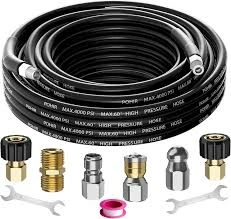How to Install High Pressure Power Steering Hose - Step-by-Step Guide
How to Install a High Pressure Power Steering Hose
Installing a high pressure power steering hose is an essential task for maintaining the efficiency and performance of your vehicle's steering system. Over time, hoses can wear out, leading to leaks and reduced steering responsiveness. This guide will help you through the process step-by-step, ensuring a successful installation.
Tools and Materials Needed
Before you begin, gather the necessary tools and materials
- New high pressure power steering hose - Socket set - Wrench set - Screwdriver - Pliers - Power steering fluid - Drain pan - Safety glasses - Rags or paper towels
Steps to Install a High Pressure Power Steering Hose
1. Preparation Start by parking your vehicle on a flat surface and turning off the engine. Allow it to cool down if it has been running recently. Wear your safety glasses to protect your eyes during the installation.
2. Lift the Vehicle Use a jack and jack stands to elevate the front end of the vehicle if necessary. This allows for better access to the power steering components.
3. Locate the Hose Identify the high pressure power steering hose. It runs from the power steering pump to the steering gear or rack. Check your vehicle’s service manual for specific details about your model.
how to install high pressure power steering hose

4. Drain the Fluid Place a drain pan under the power steering pump. Carefully remove the cap and allow the fluid to drain out. This can help prevent spills and make the process cleaner.
5. Remove the Old Hose Use the appropriate wrench to loosen the fittings on both ends of the old hose. Carefully disconnect the hose from the power steering pump and the steering gear. If the hose is stuck, use pliers for added leverage but be careful not to damage surrounding components.
6. Install the New Hose Take your new high pressure power steering hose and align it with the fittings. Hand-tighten the fittings first to avoid cross-threading. Once secure, use a wrench to tighten them firmly, but be cautious not to overtighten, as this can damage the fittings.
7. Refill Power Steering Fluid After the new hose is in place, refill the power steering fluid reservoir with the recommended fluid for your vehicle. Be sure to check your owner’s manual for the correct type.
8. Check for Leaks Start the engine and turn the steering wheel back and forth to circulate the fluid. Inspect the connections for any signs of leaks. If you notice any, tighten the fittings as necessary.
9. Finish Up Once you’re confident there are no leaks, place the cap back on the power steering fluid reservoir. Lower the vehicle if it was lifted and clean up any spilled fluid.
Conclusion
Installing a high pressure power steering hose may seem daunting, but with the right tools and careful execution, it can be accomplished by most DIY enthusiasts. Regular maintenance and timely replacements will ensure your steering system remains efficient, providing a safe and smooth driving experience. Always refer to your vehicle’s service manual for specific instructions related to your make and model.
-
Ultimate Spiral Protection for Hoses & CablesNewsJun.26,2025
-
The Ultimate Quick-Connect Solutions for Every NeedNewsJun.26,2025
-
SAE J1401 Brake Hose: Reliable Choice for Safe BrakingNewsJun.26,2025
-
Reliable J2064 A/C Hoses for Real-World Cooling NeedsNewsJun.26,2025
-
Heavy-Duty Sewer Jetting Hoses Built to LastNewsJun.26,2025
-
Fix Power Steering Tube Leaks Fast – Durable & Affordable SolutionNewsJun.26,2025

